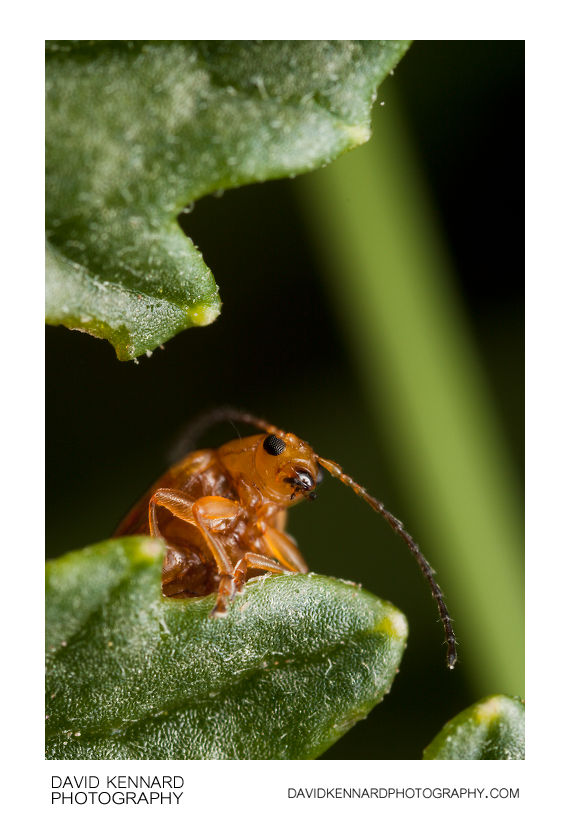Tansy Ragwort Flea Beetle (Longitarsus jacobaeae)

Description
- Title:
- Tansy Ragwort Flea Beetle (Longitarsus jacobaeae)
- Caption / Description:
-
Longitarsus jacobaeae is a species of flea beetle known as the tansy ragwort flea beetle. It is used as an agent of biological pest control against the noxious weed known as ragwort (Senecio jacobaea).
The adult tansy ragwort flea beetle is light golden brown in color and between 2 and 4 millimeters long. The female is larger than the male, especially when gravid (pregnant). Like other flea beetles, Longitarsus jacobaeae has enlarged femurs which enable it to jump out of danger if disturbed.
The female ragwort flea beetle lays eggs on or near ragwort, its host plant. The larva then emerges about two weeks later and will burrow into the ground to feed on the roots. The larvae and adults are dually responsible for damage to the plant - the adult defoliates plants which are often already weakened by larval damage at the roots.
This two-pronged attack is quite successful in preventing ragwort growth and development. The tansy ragwort flea beetles have prevented entire populations of ragwort from reaching flowering stage at several monitored sites.
The beetle is not choosy about the genera in which it feeds from, and recent studies with Longitarsus jacobaeae have shown "that selection pressure by specialist herbivores is not likely a driving force in evolutionary diversification" of the plants which contain the alkaloids that the beetle dines on.
The tansy ragwort flea beetle is native to Eurasia. It was first introduced to the United States as a ragwort biocontrol agent in 1969 and it is now established in much of the western United States.
Description adapted from Wikipedia: http://en.wikipedia.org/wiki/Longitarsus_jacobaeae
- Tags / Keywords:
-
- Biota
- Life
- Vitae
- Eukaryota
- Animalia
- Animals
- Arthropoda
- Arthropods
- Insecta
- Insects
- Coleoptera
- Beetles
- Chrysomelidae
- Leaf beetles
- Ragwort
- Longitarsus
- Longitarsus jacobaeae
- Tansy Ragwort Flea beetle
Admin
- Date Original Photo Taken:
- Original File Name:
- _MG_7594.CR2
- Event:
- Rating:
- ☆
- Date this image added/last updated on website:
- Original File Dimensions:
- 2848px x 4272px
- File Type:
- JPEG
- Color Mode:
- RGB
- Original Image Color Profile:
- Adobe RGB (1998)
Location
- Location Created:
-
- Sublocation:
- City:
- Market Harborough
- Province/State:
- Leicestershire
- Country:
- United Kingdom
- World Region:
- Europe
- Geo-location:
Rights
- Copyright Status:
- Copyrighted
- Licensing Status:
- Rights Managed
- Available for Editorial Use:
- Yes
- Available for Commercial Use:
- Yes
- Copyright Notice:
- © 2009 Dave Kennard
Camera Data
- Date Digital Resource was created:
- Shutter speed:
- 1⁄200 s
- Aperture:
- f/8
- Camera Model:
- Canon EOS 450D
- ISO:
- 100
- Exposure Compensation:
- 0
- Focal Length:
- 65mm
- Focal Length (35mm equiv.):
- Metering Mode:
- Multi-segment
- Flash:
- Off, Did not fire
- Exposure Mode:
- Manual
- White Balance:
- Manual
- Light Source:
- Exposure Program:
- Manual
Additional shooting metadata
- Lens:
- Canon MP-E 65mm F2.8 1-5x Macro
- Filters used:
- Additional Optics used:
- Setup:
- Handheld
Canon MT-24EX Macro Twin flash with home-made diffuser Mk. II (large) on top flash head and Home-made diffuser mk. III on the side flash head
Post Processing
- Image Modified:
- Software used:
-
- Adobe Camera RAW
- Post Processing:
Curves adjustment in ACR to brighten and increase contrast
